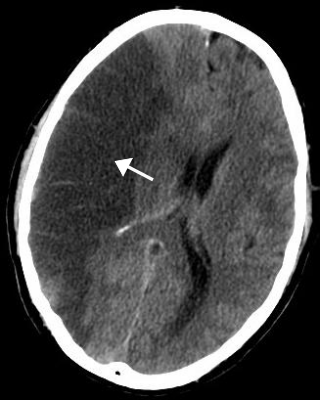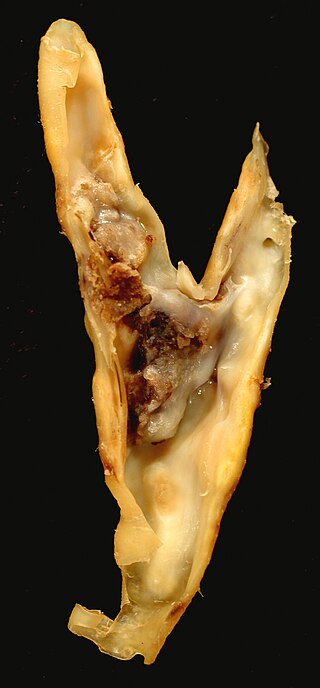A transient ischemic attack (TIA), commonly known as a mini-stroke, is a minor stroke whose noticeable symptoms usually end in less than an hour. TIA causes the same symptoms associated with strokes, such as weakness or numbness on one side of the body, sudden dimming or loss of vision, difficulty speaking or understanding language, slurred speech, or confusion.
Vascular dementia (VaD) is dementia caused by problems in the supply of blood to the brain, typically a series of minor strokes, leading to worsening cognitive abilities, the decline occurring piecemeal. The term refers to a syndrome consisting of a complex interaction of cerebrovascular disease and risk factors that lead to changes in brain structures due to strokes and lesions, resulting in changes in cognition. The temporal relationship between a stroke and cognitive deficits is needed to make the diagnosis.

Cerebrovascular disease includes a variety of medical conditions that affect the blood vessels of the brain and the cerebral circulation. Arteries supplying oxygen and nutrients to the brain are often damaged or deformed in these disorders. The most common presentation of cerebrovascular disease is an ischemic stroke or mini-stroke and sometimes a hemorrhagic stroke. Hypertension is the most important contributing risk factor for stroke and cerebrovascular diseases as it can change the structure of blood vessels and result in atherosclerosis. Atherosclerosis narrows blood vessels in the brain, resulting in decreased cerebral perfusion. Other risk factors that contribute to stroke include smoking and diabetes. Narrowed cerebral arteries can lead to ischemic stroke, but continually elevated blood pressure can also cause tearing of vessels, leading to a hemorrhagic stroke.

A stroke is a medical condition in which poor blood flow to the brain causes cell death. There are two main types of stroke: ischemic, due to lack of blood flow, and hemorrhagic, due to bleeding. Both cause parts of the brain to stop functioning properly.

Carotid endarterectomy is a surgical procedure used to reduce the risk of stroke from carotid artery stenosis. In endarterectomy, the surgeon opens the artery and removes the plaque. The plaque forms and thickens the inner layer of the artery, or intima, hence the name of the procedure which simply means removal of part of the internal layers of the artery.

Sneddon's syndrome is a form of arteriopathy characterized by several symptoms, including:

Tinzaparin is an antithrombotic drug in the heparin group. It is a low molecular weight heparin (LMWH) marketed as Innohep worldwide. It has been approved by the U.S. Food and Drug Administration (FDA) for once daily treatment and prophylaxis of deep vein thrombosis (DVT) and pulmonary embolism (PE).

Technetium (99mTc) exametazime is a radiopharmaceutical sold under the trade name Ceretec, and is used by nuclear medicine physicians for the detection of altered regional cerebral perfusion in stroke and other cerebrovascular diseases. It can also be used for the labelling of leukocytes to localise intra-abdominal infections and inflammatory bowel disease. Exametazime is sometimes referred to as hexamethylpropylene amine oxime or HMPAO, although correct chemical names are:
Louis R. Caplan is an American physician who is a senior member of the Division of Cerebrovascular Disease at Beth Israel Deaconess Medical Center, Boston. He is a Professor of Neurology at Harvard Medical School, Boston, and the founder of the Harvard Stroke Registry at Beth Israel Deaconess Medical Center. Caplan is the author or editor of 51 books and more than 700 articles in medical journals.
Recent epidemiologic studies confirm that stroke is the most frequent cause of death in the People's Republic of China, with an incidence more than fivefold that of myocardial infarction. Intracerebral hemorrhage causes about one third of all strokes, nearly three times the frequency in North American stroke registries. A marked regional variation in stroke incidence exists, with a threefold higher stroke incidence in northern than in southern Chinese cities, suggesting important environmental or dietary influences. Stroke treatment often involves a combination of modern and traditional herbal medicine; the latter may modify platelet aggregation and blood viscosity. Stroke, particularly intracerebral hemorrhage, is the most frequent and important vascular disorder in China.

Terutroban is an antiplatelet agent developed by Servier Laboratories. It is a selective thromboxane prostanoid (TP) antagonist and is an orally active drug in clinical development for the secondary prevention of acute thrombotic complications.
The Center for Cerebrovascular Research at the University of California, San Francisco is a collective of faculty and staff investigating matters related to cerebral circulation, particularly cerebrovascular disease resulting from narrowing of major blood vessels in the brain and vascular malformation of the brain. While research offices are located on Parnassus campus, San Francisco General Hospital hosts the center's laboratories and facilities. The center coordinates with additional faculty in various fields of neuroscience and vascular biology. Sponsors include the National Institute of Neurological Disorders and Stroke and the UCSF departments of Anesthesia, Neurological Surgery and Neurology.
Pankaj Sharma is a British Professor of Clinical Neurology at Royal Holloway College, University of London, and consultant neurologist at Imperial College London. He is director of the Institute of Cardiovascular Research at Royal Holloway (ICR2UL), and formerly head of the Imperial College Cerebrovascular Research Unit (ICCRU) at Imperial College London. His main interest is in identifying genes for stroke, particularly in those of South Asian heritage.

Piclozotan (SUN-N4057) is a selective 5-HT1A receptor partial agonist, which has neuroprotective effects in animal studies. It has been through early clinical trials in humans for treatment of acute stroke, but results have not yet been announced.

Barrow Neurological Institute is the world's largest neurological disease treatment and research institution, and is consistently ranked as one of the best neurosurgical training centers in the United States. Founded in 1962, the main campus is located at 350 W. Thomas Road, Phoenix, Arizona.

Journal of the American Heart Association: Cardiovascular and Cerebrovascular Disease is a peer-reviewed open access scientific journal and an official journal of the American Heart Association. Since 2015, it is also published with John Wiley & Sons. It was established in 2012 and the editor-in-chief is Bruce Ovbiagele.
José Biller is an Uruguayan born, American neurologist specialized in stroke and cerebrovascular disorders, currently professor and chairperson of the department of neurology at Loyola University Chicago, Stritch School of Medicine, the Editor-in-Chief of Journal of Stroke & Cerebrovascular Diseases, a Foreign Academic Correspondent of the National Academy of Medicine in Uruguay, a Fellow of the Mexican Academy of Neurology and an Honorary Member of the Chilean Society of Neurology, Psychiatry and Neurosurgery.
Cerebrovascular Diseases is a peer-reviewed medical journal covering the study of cerebrovascular diseases. It was established in 1991 by Michael G. Hennerici and Julien Bogousslavsky, and is published eight times per year by Karger Publishers. Hennerici is the journal's editor-in-chief. According to the Journal Citation Reports, the journal has a 2016 impact factor of 2.974.

Cerebrovascular diseases in Australia are a major health issue. Cerebrovascular disease is a significant challenge to Australia due to it being a prominent cause of death in Australians and the difficulties it poses for carers and the health system in addition to individuals with cerebrovascular disease. Stroke is the deadliest cerebrovascular disease in Australia accounting for 84.24% of all deaths caused by cerebrovascular diseases. The death rate of cerebrovascular diseases is decreasing, with cerebrovascular disease in 2008-2018 falling from the third to fourth leading cause of death for men and second to third leading cause of death for women during this time period. In 2015, stroke was the tenth leading cause of burden of disease, accounting for 2.7% of the overall burden. This cause of disease burden has decreased from 2003-2015 with stroke falling from the second leading cause of disease burden to the tenth during this time period. Aboriginal and Torres Strait Islander people and people from low-socioeconomic areas experience higher rates of prevalence and mortality from stroke than non-Indigenous Australians.

Raad Shakir CBE is Professor of Neurology at Imperial College London and a Consultant Neurologist at Charing Cross Hospital.












